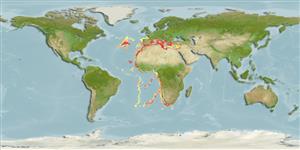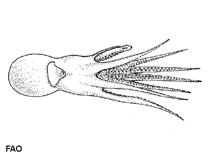Bathypolypus sponsalis (Fischer & Fischer, 1892)
Globose octopus| Native range | All suitable habitat | Point map | Year 2050 |

|
| This map was computer-generated and has not yet been reviewed. |
| Bathypolypus sponsalis AquaMaps Data sources: GBIF OBIS |
Классификация / Names народные названия | синонимы | CoL | ITIS | WoRMS
Cephalopoda | Octopoda | Octopodidae | Bathypolypodinae
Environment: milieu / climate zone / пределы глубины / distribution range экология
батидемерсальный; пределы глубины 200 - 2300 m (ссылка 104052), usually 400 - 700 m (ссылка 1958). Subtropical; 12°C - ? (ссылка 1964)
Distribution страны | регионы FAO | Ecosystems | места находок | интродукции
Eastern Atlantic and the Mediterranean: Iberian Peninsula from Bay of Biscay to Cape Verde.
Length at first maturity / Size / Weight / Возраст
половая зрелость: Lm ? range ? - ? cm Max length : 10.0 cm ML самец/пол неопределен; (ссылка 104052)
Life cycle and mating behavior половая зрелость | размножение | нерест | Eggs | Fecundity | Larvae
Основная ссылка
ссылки | координатор | соавторы
Quetglas, A, M. Gonzales, A. Carbonell and P. Sánchez 2001 Biology of the deep-sea octopus Bathypolypus sponsalis (Cephalopoda: Octopodidae) from the wetern Mediterranean Sea. Mar. Biol. 138:785-792. (ссылка 1958)
Статус Красного Списка МСОП
(ссылка 130435: Version 2025-1)
Статус СИТЕС (ссылка 108899)
CMS (ссылка 116361)
Угроза для людей
Использование человеком
| FishSource |
инструменты
дополнительная информация
ресурсы в Интернет
BHL | BOLD Systems | CISTI | DiscoverLife | FAO(Publication : search) | Fishipedia | GenBank (Геном, Нуклеотид) | GloBI | Gomexsi | Google Books | Google Scholar | Google | PubMed | Tree of Life | Wikipedia (Вперёд, поиск) | Zoological Record



